You must have been born in Alsace or Germany to know about Christkindel, an enigmatic figure in Alsatian and German Christmas. A discreet figure, he is rarely seen at Alsatian Christmas markets... but with a little patience, you're sure to come across him!
Who is Christkind?
First of all, there's something strange about the nominal gender. In French. we say LE Christkind, so it's masculine. The German translation is "Christ Child". Except that... in popular Germanic imagery, the character takes the form of a young girl wearing a crown adorned with four candles. Who knows why?
Obscure origins...
In fact, we wanted to know why. And we went back a long way. First, among the Celts, a female figure embodied fertility. In the middle of winter, she heralded the next cycle of nature.
Then, among the Scandinavians, we find another woman in the person of Saint Lucia. Still celebrated today in these northern European countries, she looks almost like a twin sister of Christkind, with her four candles on her head. It has to be said that the celebration of Saint Lucia, which takes place on the 23rd of December, and her relationship with light may well have inspired the figure of Christkind.

Saint Lucia greetings card by Adèle Söderberg (early 20th century). Source: Public Domain via Wikimedia Commons
Saint-Nicolas fired outright!
But to find out more about the origins of the mysterious young girl, let's look back to the time of the Reformation, in the 16th century. This break with Catholicism led to changes in local traditions. Until the Reformation, St Nicholas was venerated on the 6th of December in much of German-speaking Europe. This is why, in the Middle Ages, presents were not given on Christmas Eve or Christmas Day, but on the 6th of December (St Nicholas Day) or the 28th of December (Innocents' Day).

Saint Nicolas in Nancy, France © French Moments
But the Protestants were not at all in favour of the cult of saints. And St Nicholas paid the price. The St Nicholas markets were simply cancelled. The emblematic bishop was no longer allowed to be mentioned in towns and villages that had become Protestant, such as Strasbourg. Out with Nick, but who would replace him?
Martin Luther fundamentally rejected the cult of the saints. For him, Jesus Christ, Son of God is the only mediator between God and human beings, and the legend of Saint Nicholas would be a "childish thing", even a lie, as he declared in a sermon for the feast of Saint Nicholas in 1527:
"Saint Nicholas is not to be equated with the true Saint, Jesus Christ. The term sacred is reserved only for the Messiah and not for any bishop of Myre. This is what evangelical faith in God supports!"
The birth of Christkind at the Reformation
They needed a figure that would remind us of God's gift to mankind—an emblem of the birth of the Christ Child on Christmas night.
And legend has it that Martin Luther himself came up with the idea of personifying Christmas with an effigy of the baby Jesus.
Was he inspired by Saint Lucia or another popular image? Or were the features of a young girl added in later centuries?
No one really knows. So much so that, in the middle of the 16th century, yet another gift-giver was created from scratch: Christkind.
The spread of a new 16th-century tradition
The German folklorist and historian Reinhold Köhler (1830-1892) was of the opinion that the extent to which the increasing spread of the Reformation had ousted Saint Nicholas in favour of Christkind could be determined by the bans issued by Protestant town administrations.
For example, in 1570, on the advice of the pastor of Strasbourg cathedral, the magistrate decided to ban St Nicholas parades in order to teach children that it was not the saint but Christkind who brought the presents.

Martin Behm
Then, in 1608, the German pastor Martin Behm (1557-1622) preached: "It is unfortunate that some parents place something on their children's beds and say that it is a gift from Saint Nicholas. This is a bad habit, because it diverts the children's attention from the Saint, whereas we know that it is not Saint Nicholas, but the Holy Child Jesus who brings all good things for body and soul. We should recognise him and invoke him alone for this purpose."
At the start of the Reformation in the 16th century, the birth of Christ was celebrated exclusively in the church. Celebrating the feast at home was rare, and in the Protestant regions of Germany was reserved for the privileged.
Christkind: where does your name come from?
His name derives from an abbreviation of "Christus als Kind". In German, this became "Christ-Kindel" (Christ the child). In other German territories, similar spellings can be found: Christkind (Germany), Christkindel (Alsace), Christkindla (Sundgau in Alsace), Chrischtchindli (German-speaking Switzerland) or Christkindl (particularly in Austria). So Christkind wasn't born at Christmas but at the Reformation!
The Christkind made its first appearance during the life of the reformer Martin Luther, in the first half of the 16th century. The idea was to refocus the celebration of Christ's birth and reflect it in new customs. In Germany's predominantly Protestant regions, for example, it is now traditional to give presents on Christmas Day, 25th of December.
This Protestant Reformation invention was not the only one to develop at Christmas time. The decorated Christmas tree was encouraged by the Reformers to replace the nativity scene. As for the large St Nicholas market in Strasbourg, considered a "relic of papism", it was replaced in 1570 by a Christmas market in its own right. Dedicated to Christkindel, the Christkindelsmärik is French for "Christ Child Market".

The entrance to the "Christkindelsmärik" in Strasbourg © French Moments
When history takes us by surprise
From the 16th century onwards, Christkindel took the place of Saint Nicolas in the processions organised in the towns and villages of Alsace. Young teenagers of both sexes, dressed in white, would make the rounds of the houses. They handed out sweets and sang carols. Some young men and women got into mischief together. In the 17th and 18th centuries, the Protestant authorities took action on several occasions to combat these problems of morality.
But let's put the central role played by Christkindel into perspective. Saint-Nicolas had not completely disappeared from the landscape and was still deeply rooted in the hearts of Alsatians.
It's all reversed!
But the course of history sometimes reveals some surprising twists. Although the Protestant Reformation invented the Christkind, it is in the predominantly Catholic German-speaking countries that the tradition has been maintained to this day. Protestant Germany has since succumbed to the charms of the American Father Christmas (Santa Claus), whose ancestor is none other than... Saint Nicholas the Catholic!
And to make matters worse, the tradition of Christkind has evolved so much over the centuries that the meaning given to it by the Reformation has now been forgotten. And Alsatian children barely even know it exists!

Advent calendar (1903) featuring Christkind by Richard Ernst Kepler
The popularity of the Weihnachtsmann (German Santa) spread throughout Germany from the 19th century onwards, gradually replacing the Christkind as the gift-giver in Protestant areas, particularly in northern and eastern Germany. However, the Christkind continued to play this role in Catholic customs.
As a result, this figure is still very much in evidence today in predominantly Catholic regions such as Bavaria, Baden-Württemberg, the Rhineland and Austria.
However, Christkind still brings Christmas presents to traditionally Protestant households in Franconia, Baden-Württemberg, the Palatinate and Hesse.
What does Christkind look like?
In the German tradition, the Christkind (or Christkindel) has several characteristics - here are a few from the Alsace region in today's France:
- He takes the form of a young girl, like an angel or the Christianised image of a fairy.
- The girl is dressed all in white and wears a veil (also white!).
- Her head is crowned with a golden fir tree wreath. She is adorned with four lit candles. This makes her a twin sister of Saint Lucia!
- He sometimes holds a stick with a star on it.
- He is assisted by a donkey called Peckeresel. In his two leather saddlebags are treats (mandarins and Alsatian Christmas cookies) for good children and whips for bad ones.
- He is often accompanied by Hans Trapp, a fearsome character who acts as Père Fouettard in Alsace. He has the (thankless) task of scaring naughty children.

Christkindel and Hans Trapp visiting a family in Alsace (1858)
Initially, the Christkind was visually designed to resemble the newborn Jesus. Over time, however, this figure took on a distinct identity in tradition. The idea of an angelic figure emerged, losing the initial resemblance to Jesus.
This development could be attributed to the fact that in the past, during nativity scenes and Christmas parades, the infant Jesus was often accompanied by a group of angels inspired by the angel of the Annunciation. The angels were played by young girls dressed in white dresses. The colour white was chosen as a reference to the purity and innocence of the figure.
Finally, Christmas researchers are now unanimous in saying that the Christkind is neither a girl nor a boy. The Christkind is, therefore, genderless, or more precisely, sex-neutral. But in reality, this is not entirely true: in Nuremberg, as in Lower Alsace, Christkind always appears as a young girl (and never as a boy)!
![Christkind-2018-02-©-Stefan-Brending-licence-CC-BY-SA-3.0-de-from-Wikimedia-Commons Christkind de Nuremberg en 2018 © Stefan Brending - licence [CC-BY-SA-3.0-de] from Wikimedia Commons](https://frenchmoments.eu/wp-content/uploads/2023/12/Christkind-2018-02-©-Stefan-Brending-licence-CC-BY-SA-3.0-de-from-Wikimedia-Commons.jpg)
Christkind of Nuremberg in 2018 © Stefan Brending - licence [CC-BY-SA-3.0-de] from Wikimedia Commons
Where is Christkind celebrated?
Unsurprisingly, Christkind is celebrated in German-speaking countries. Alsace, Southern Germany, Austria, Croatia, Hungary, Slovenia, German-speaking Switzerland, the Czech Republic, Southern Tirol (Italy), as well as parts of Brazil (where German populations have emigrated).
Christkind from Nuremberg
In Nuremberg, the Christkind tradition remains the most popular in the world, even in the 2020s. Father Christmas and St Nicholas don't stand a chance here, whether in homes, schools or offices.
The presence of Christkind in Nuremberg during the Christmas season is omnipresent. It's everywhere: in shop windows, on tourist posters and leaflets, on Christmas decorations, on local TV and radio, and even on postage stamps! Christkind is also physically represented by amateur actors at children's festivities.
So it's hardly surprising that Nuremberg's long-established Christmas market, steeped in tradition, goes by Christkindlesmarkt. Young women who physically embody Christkind are a regular sight in this market.
Every year, the former imperial city searches for a young woman aged 16 or over to take on the noble task of representing Christkind throughout the wonderful Advent and Christmas period. Between selfies, speeches, interviews and events, this temporary representative of Christkind will have a lot to do!
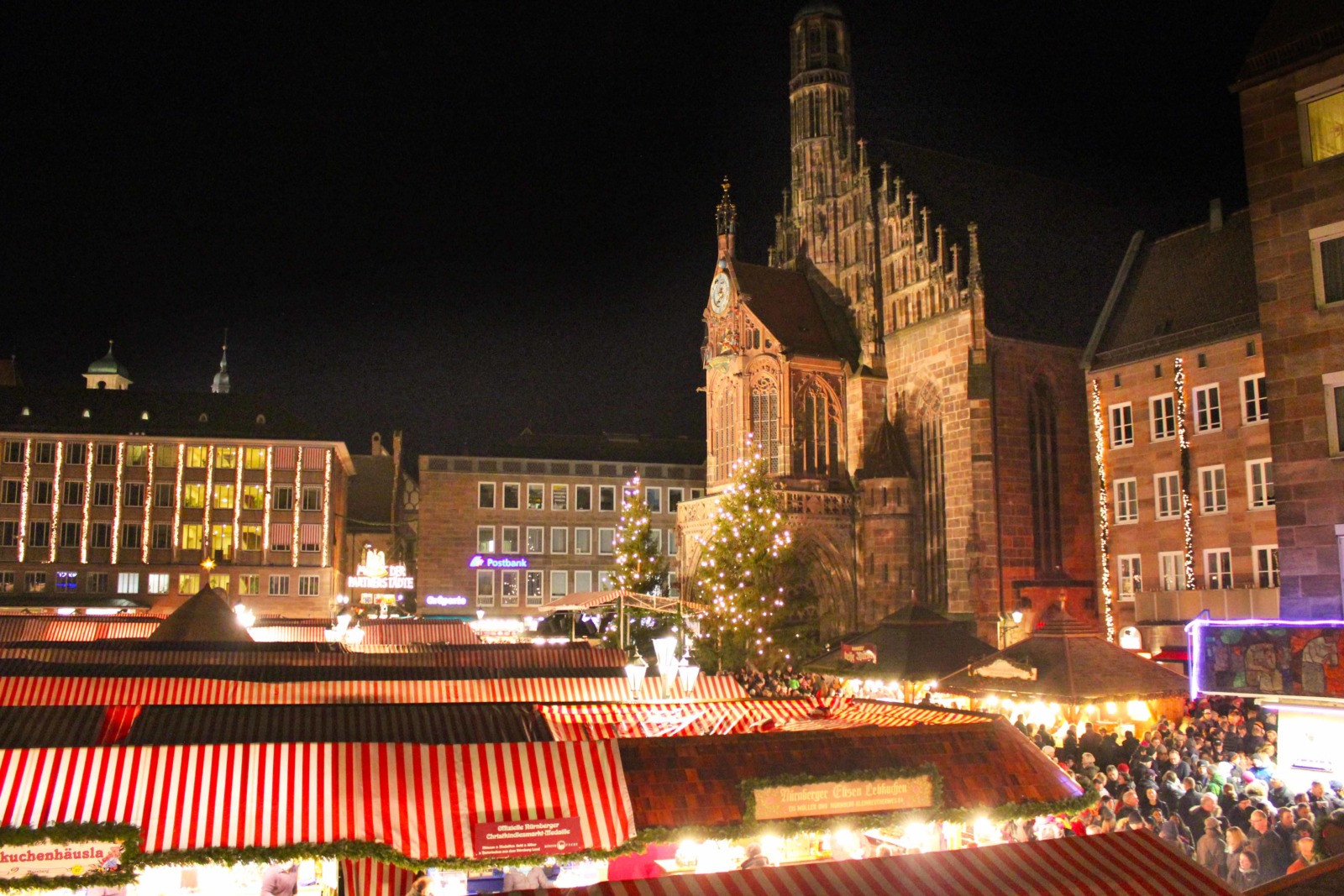
Nuremberg Christmas Market by reinasierra via Twenty20
Christmas markets in honour of Christkind
The influence of Christkind can be seen in the names of German Christmas markets:
- Strasbourg in France (Christkindelsmärik),
- Augsburg (Augsburger Christkindlmarkt),
- Munich (Christkindlmarkt am Marienplatz),
- Karlsruhe (Karlsruher Christkindelsmarkt),
- Görlitz in Saxony (Schlesische Christkindelmarket),
- Vienna in Austria (Wiener Christkindlmarkt),
- Linz (Linzer Christkindlmärkte),
- Salzburg (Salzburger Christkindlmarkt),
- Zurich in Switzerland (Christkindlimarkt im Hauptbahnhof),
- Bolzano in Italy (Bozner Christkindlmarkt),
- without forgetting the Christmas market in... Chicago in the USA!
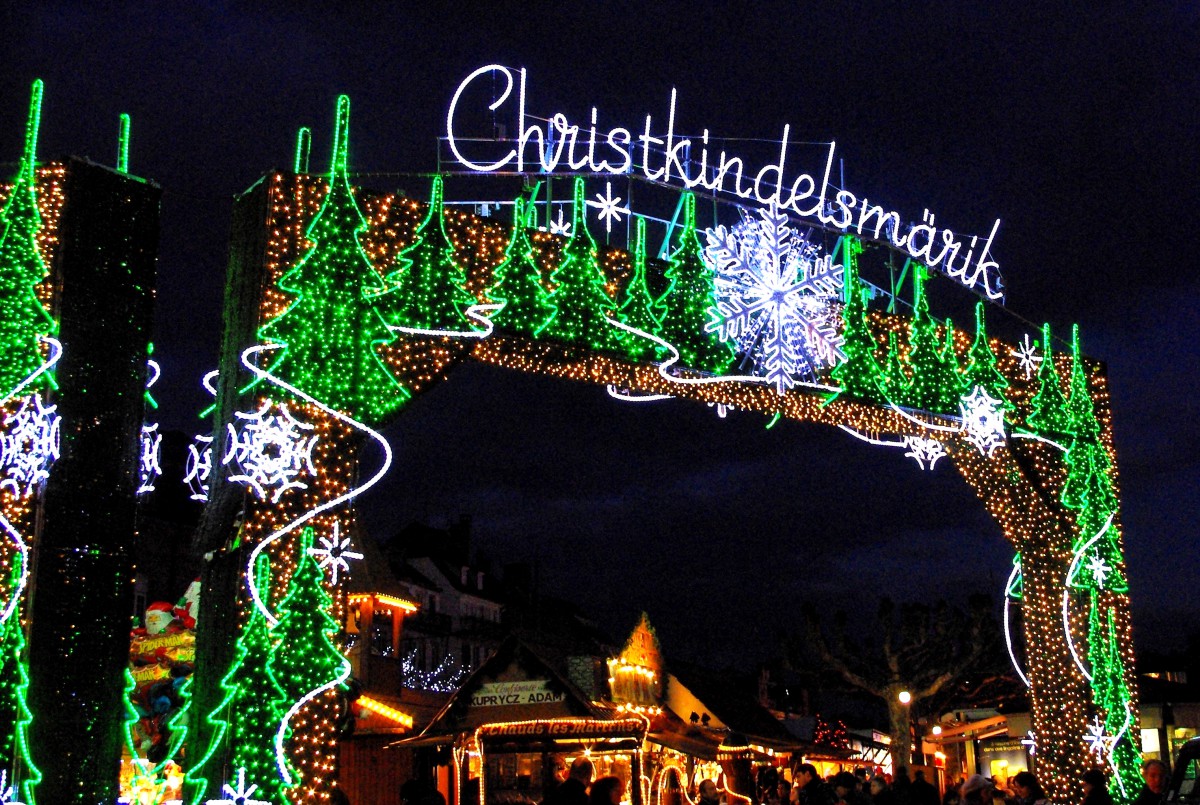
The former entrance to the Christkindelsmärik in Strasbourg (2012) © French Moments
In Alsace, Christkindel has been back in the limelight since the 1990s and is playing an increasingly important role in popular imagery, along with the development of Christmas markets. It's no longer incongruous to find Christkindel, St Nicholas and Hans Trapp side by side.
To catch a glimpse of the Alsatian Christkindel, it's best to visit Lower Alsace at Christmas, and in particular the little market town of Wissembourg, on the border with the Palatinate.
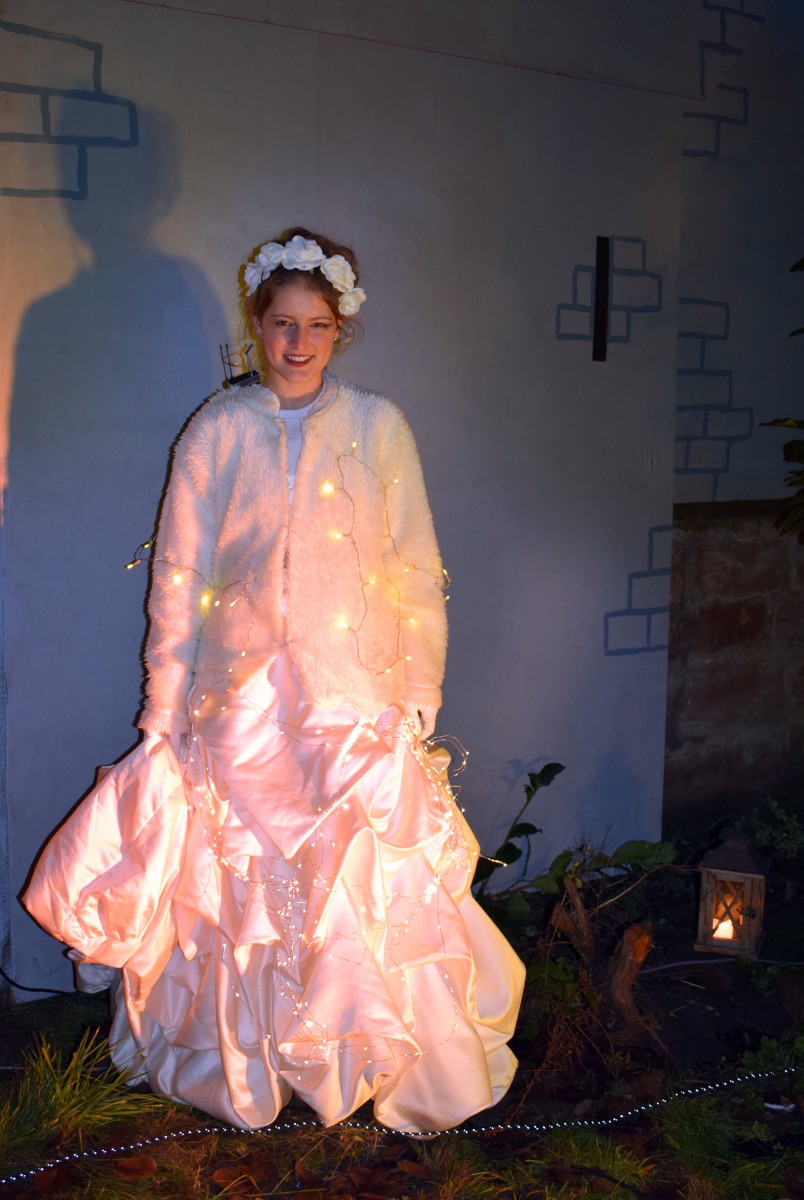
Christkindel in Wissembourg © French Moments
Is Christkind endangered?
Is the Christkind on the verge of extinction? It's reasonable to wonder because when it comes to handing out presents, the competition is fierce!
Of course, there's Saint Nicholas and, above all, Father Christmas, whose big, red-clad face comes from America.
In Germany, other (chocolate) characters made their appearance and enjoyed a certain popularity: Lindt's Winter Bear and Milka's Snowman. Just like Coca-Cola's Santa Claus, here we are dealing with brands.
Studies prove it!
The fact is that it is in Austria and southern Germany that the Christkind tradition has remained tenacious in the face of Father Christmas. These are the findings of a survey carried out by the Austria Press Agency (APA) in 2017. To carry out the survey, APA used data from users of social networks such as Facebook and Twitter.
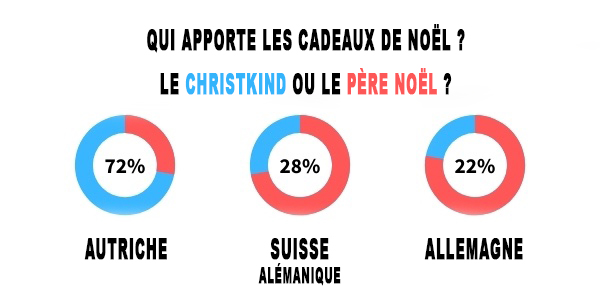
(Who bring the Christmas presents in Austria, German-speaking Switzerland and Germany? Data: APA – Austrian Press Agency 2017)
Wouldn't the Christkind sell well?
German folklorist and anthropologist Gunther Hirschfelder notes that Christkind is less amenable to media commercialisation than Father Christmas. In his view, Christkind is not well represented in the media when it comes to buying and giving Christmas presents.
In the language of the media and advertising industry, the Christkind is a young character (aged between 14 and 16), scantily clad and varying in appearance from androgynous to feminine. Not a great selling point at a time when the constant sexualisation of images and content is decried.
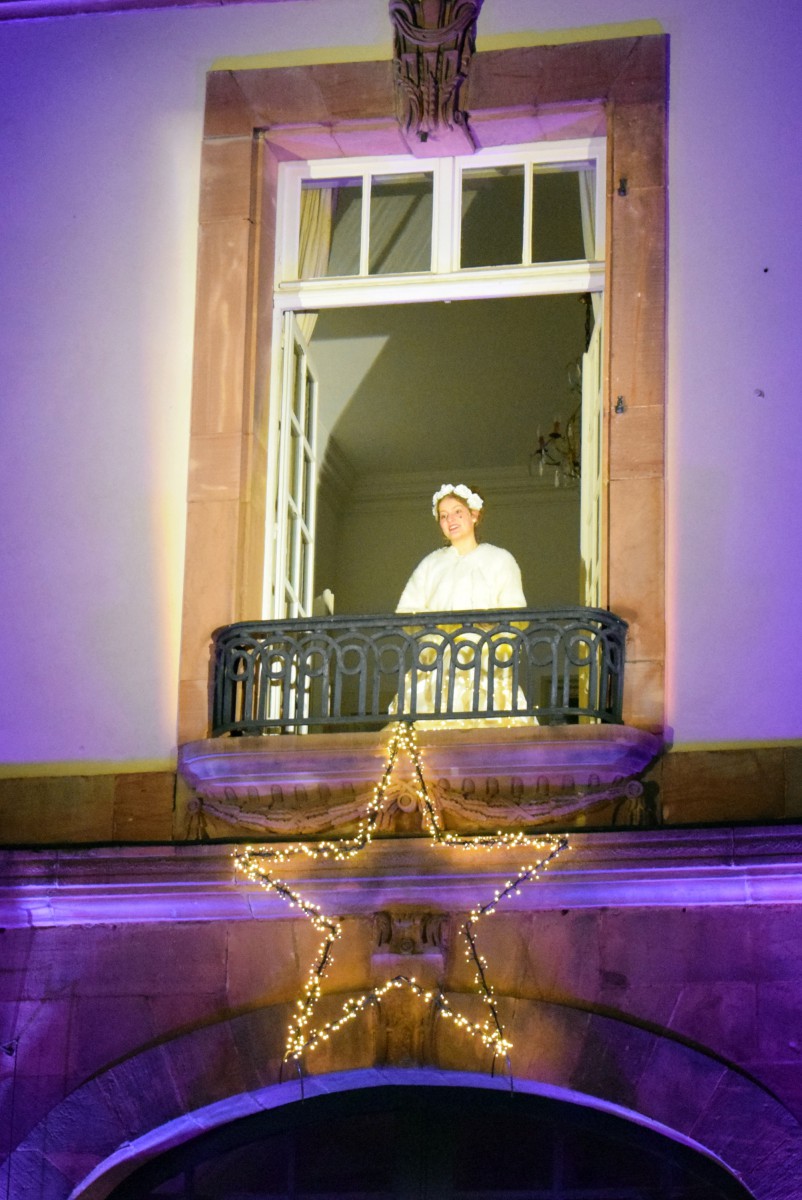
Christkindel appearing from a window in Wissembourg (Alsace) © French Moments
A white (and cold) Christmas!
What's more, Christmas has become a celebration with an increasingly wintry image, echoing the American song "I'm Dreaming of a White Christmas". Gunther Hirschfelder adds: "However, you can't make Christkind wintry, because he's always lightly clad and derives from the shape of angels. An angel in a winter coat just doesn't work."
Fortunately for Christkind, there are still bastions that resist the invaders. In Nuremberg and Wissembourg, for example, the tradition of Christkind and Christkindel is set to continue!

Detail of the garlands with the representation of Christkindel at the Ecomusée d'Alsace © French Moments
Find out more!
Here are a few links to the blog and other websites about Christkind in Germany and Christkindel in Alsace:
- Read this article in French on our blog Mon Grand-Est
- Saint Nicolas: origins and traditions [on the blog]
- Hans Trapp, the terror of the Alsatian children [on the blog]
- The formidable story of Santa Claus [on the blog]
- Christmas presents in France: Origins and Traditions [on the blog]
- Nuremberg Christmas Market: a discovery-guide [sur le blog]
- Wissembourg : Christmas market, Hans Trapp and Christkindel [on the French blog]
- Martin Luther's Christ Child has replaced St Nicholas [in German]
- Christmas characters in German-speaking Switzerland [in German]
- The wonderful Christmas tradition for children [in German]
Have you come across the Christkind in Alsace, Germany or Austria? Let us know by leaving us a comment!



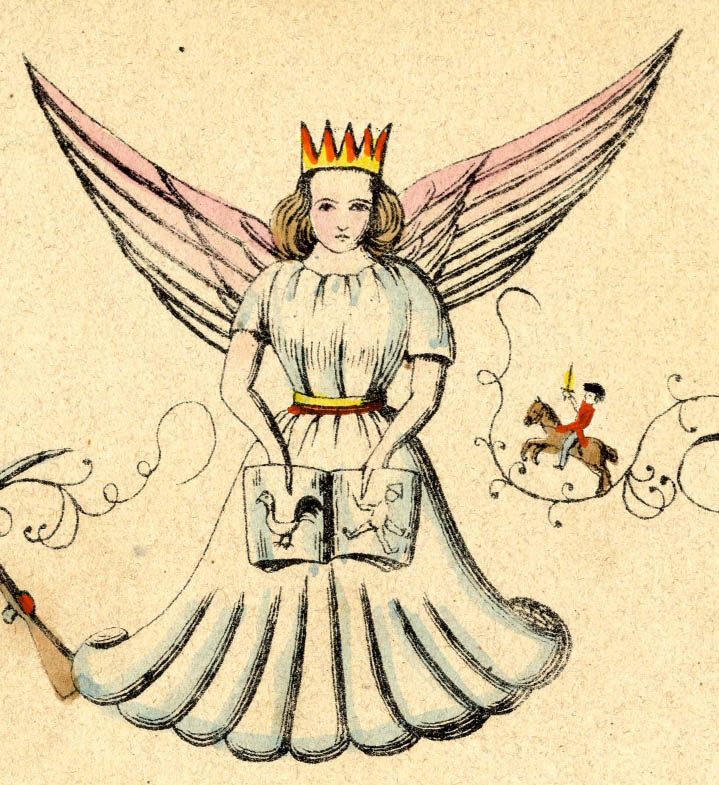
![Christkindlesmarkt-prologue-2009-©-Roland-Berger-licence-CC-BY-SA-3.0-from-Wikimedia-Commons Christkind de Nuremberg © Roland Berger - licence [CC-BY-SA-3.0] from Wikimedia Commons](https://frenchmoments.eu/wp-content/uploads/2023/12/Christkindlesmarkt-prologue-2009-©-Roland-Berger-licence-CC-BY-SA-3.0-from-Wikimedia-Commons.jpg)
![Nurnberg-Christkindlesmarkt-©-Ailura-licence-CC-BY-SA-3.0-at-from-Wikimedia-Commons-scaled Le Christkindlesmarkt de Nuremberg © Ailura licence [CC-BY-SA-3.0 at] from Wikimedia Commons](https://frenchmoments.eu/wp-content/uploads/2023/12/Nurnberg-Christkindlesmarkt-©-Ailura-licence-CC-BY-SA-3.0-at-from-Wikimedia-Commons-scaled-1.jpg)


